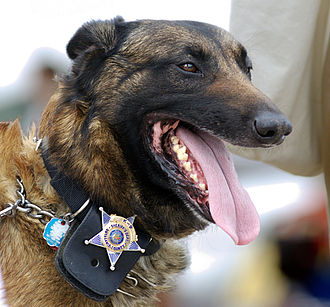Canine use in Law Enforcement

May 25, 2015 - PSPA Editorial Staff
Police Dogs (K-9)
A Police Dog, often referred to in North America as a "K-9" is a dog that is specifically trained to assist police and other law-enforcement personnel in their work. Although most Americans perceive these animals as attack dogs, their duties generally include searching for lost people, looking for crime scene evidence, drugs, bombs, weapon detection, cadaver searches, and protecting their handlers. The most common police dogs used for everyday duties are German Shepherds, though other breeds may be used to perform specific tasks. K-9’s must be highly trained and are required to remember several hand and verbal commands. In most jurisdictions, the intentional injuring or killing of a police dog is a felony.
Police dogs are in widespread use across the United States. K-9 units are operated on the federal, state, county, and local level. On the federal level, police dogs are rarely seen by the general public, though they may be viewed in some airports assisting Transportation Security Administration officials searching for explosives and weapons or by Customs and Border Protection searching for concealed narcotics and people. Some dogs may also be used by tactical components of such agencies as the Bureau of Alcohol, Tobacco, Firearms, and Explosives, the Federal Bureau of Investigation, and the United States Marshals Service.
Most police agencies in the United States (whether state, county, or local) utilize K-9s as a means of law enforcement. Often, even the smallest of police departments operates a K-9 team of at least one dog, while larger departments can be working with ten or more. Police dogs usually serve all purposes deemed necessary, most commonly suspect apprehension and narcotics detection, and teams are often on call; in the latter case, however, individual dogs usually serve individual purposes in which each particular animal is specialized, and teams usually serve scheduled shifts. In both cases, police dogs are almost always cared for by their specific handlers. K-9s are not often seen by the public, though specialized police vehicles used for carrying dogs may be seen from time-to-time.
In most states, a police dog is considered a full-fledged police officer, sometimes even given a badge. As such, most laws find assaulting a police dog to be equal or very similar to assaulting a human officer, and as a result some agencies will deem it acceptable for officers to open fire on a person who is intentionally hurting a police dog, with the intent to kill it. Police dogs also play a major role in American penal systems. Many jails and prisons will use special dog teams as a means of intervening in large-scale fights or riots by inmates. Also, many penal systems will employ dogs - usually bloodhounds - in searching for escaped prisoners.
Early History
Dogs have been used for law enforcement since at least the middle ages. Money was then set aside in the villages for the upkeep of the parish constable's bloodhounds that were used for hunting down outlaws. During King Henry I of England's reign, the constable in charge of the Royal Palaces would 'maintain the stables, kennels and mews, and be responsible for protecting and policing the whole court'. In France, dogs were used in the 14th century in St. Malo. Bloodhounds used in Scotland were known as "Slough dogs" - the word "Sleuth," (meaning detective) was derived from this.
The rapid urbanization of London in the 19th century caused a massive increase in law and disorder - a problem that was far too great to be dealt with by the existing law enforcement of the time. As a result private associations were formed to help combat crime. Night watchmen were employed to guard premises with many of these individuals provided with firearms and dogs to protect themselves from the criminal elements.
Modern Era
One of the first real attempts to use dogs to aid police in the detection of crime and the apprehension of a criminal was made in 1869 by the Commissioner of the Metropolitan Police of London, Sir Charles Warren. Warren's repeated failures at identifying and apprehending the serial killer Jack the Ripper had earned him much vilification from the press, including being denounced for not using bloodhounds to track the killer. He soon had two bloodhounds trained for the performance of a simple tracking test from the scene of another of the killer's crimes. The results were far from satisfactory, with one of the hounds biting the Commissioner and both dogs later running off, requiring a police search to find them.
It was in Continental Europe that dogs were first used on a large scale. Police in Paris began using dogs against roaming criminal gangs at night, but it was the police department in Ghent, Belgium that introduced the first organized police dog service program in 1899. These methods soon spread to Austria-Hungary and Germany; in the latter the first scientific developments in the field took place with experiments in dog breeding and training. The German police selected the German Shepherd Dog as the ideal breed for police work and opened up the first dog training school in 1920 in Greenheide. The dogs were systematically trained in obedience to their officers and tracking and attacking criminals.
In Britain, the North Eastern Railway Police were the first to use police dogs in 1908 to put a stop to theft from the docks in Hull. By 1910, railway police forces were experimenting with other breeds such as Labrador Retrievers, Doberman Pinschers, and German Shepherds.
Specialized Police Dogs
Search and Rescue Dogs - This dog is used to locate suspects or find missing people or objects. Bloodhounds are often used for this task.
Detection Dog or Explosive Sniffing Dogs - Some dogs are used to detect illicit substances such as drugs or explosives which may be carried on a person in their effects. In many countries, Beagles are used in airports to sniff the baggage for items that are not permitted; due to their friendly nature and appearance, the Beagle does not worry most passengers.
Arson Dogs - Some dogs are trained to pick up on traces of accelerants at sites of suspected arson.
Cadaver Dogs - Some dogs are trained in detecting the odor of decomposing bodies. Dogs' noses are so sensitive that they are even capable of detecting bodies that are under running water.
Pioneering work was done by Dr. Debra Komar (University of Alberta) in Association with the RCMP Civilian Search Dog Association in this area. The result was the development of training techniques that resulted in near 100% accuracy rates. Her research has been published in the Journal of Forensic Anthropology.
Popular Breeds
Some breeds are used to enforce public order by chasing and holding suspects, or detaining suspects by the threat of being released, either by direct apprehension or a method known as Bark and Hold. Police dogs, such as the German Shepherd breed, have many qualities that make them applicable for the job. A successful police dog should be intelligent, aggressive, strong, and have a good sense of smell. Many police dogs that are chosen are male and remain unneutered to maintain their aggressive behavior, however there are female police dogs which are used for rescue, tracking, and locating bombs and drugs. The most notable police dog breeds are:
American Pitbull Terrier (search and rescue/tracking, attack dog, locating bombs, drugs)
Beagle (locating bombs, drugs. Used worldwide)
Belgian Malinois (protection, attack dog, locating IEDs, locating evidence, locating drugs, prisoner transport, human tracking)
Bloodhound (odor-specific ID, tracking, locating bombs, drugs, evidence)
Doberman Pinscher (protection, attack dog)
Dutch Shepherd (protection, attack dog)
Springer Spaniel (locating bombs, drugs)
German Shepherd (protection, attack dog, ground based tracking and air based tracking, locating human remains, locating drugs, locating IEDs, locating evidence)
Labrador Retriever (locating bombs, drugs)
Retirement
Police dogs are retired if they become injured to an extent where they will not recover completely, pregnant, or raising puppies, or are too old or sick to continue working. Since many dogs are raised in working environments for the first year of their life and retired before they become unable to perform, the working life of a dog is 6–9 years.
If these dogs are killed in the line of duty they get the same honors as their human partners. The handler makes all the decisions regarding their partner.






